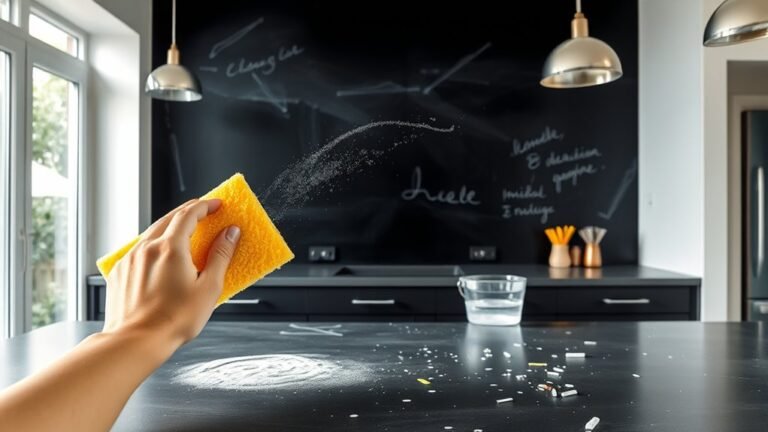Cleaning Practices for Traditional Japanese Homes
When cleaning traditional Japanese homes, you’ll want to use gentle tools like bamboo brooms and soft cloths to protect delicate tatami mats, shoji screens, and wooden floors. Avoid harsh chemicals; instead, choose natural, plant-based cleaners that preserve natural materials and indoor air quality. Regular care includes gentle vacuuming, dusting, and controlling humidity to prevent damage. Seasonal rituals also play a key role in maintaining freshness and harmony. Keep exploring to uncover more ways to honor these time-tested practices.
Essential Tools for Cleaning Traditional Japanese Interiors

To maintain the delicate balance of a traditional Japanese interior, you’ll need a few essential tools that cater specifically to its unique features. Bamboo brooms are a must-have; their gentle bristles sweep away dust without damaging delicate surfaces like tatami or shoji screens. Using natural cleaners aligns perfectly with the minimalist and eco-friendly spirit of these homes. You’ll want to choose plant-based solutions that effectively clean without leaving harsh residues or odors. Avoid chemical-heavy products that might disrupt the natural materials or your indoor air quality. With these tools, you’re not just cleaning—you’re preserving the harmony and freedom that traditional Japanese interiors offer. Embracing simplicity in your cleaning routine enhances both the space and your experience within it.
Care and Maintenance of Tatami Mats
Although tatami mats are sturdy, they require regular care to keep their natural beauty and functionality intact. You’ll want to practice consistent tatami mat care by gently vacuuming them with a soft brush attachment to remove dust and prevent mold growth. Avoid exposing them to direct sunlight for long periods, as this can cause fading and drying. Additionally, maintain good airflow in the room to reduce humidity and keep your mats fresh. If you notice significant wear, discoloration, or damage, it might be time for tatami mat replacement, ensuring your space stays authentic and comfortable. Taking these steps gives you the freedom to enjoy the traditional charm of your Japanese home without worrying about costly repairs or loss of ambiance.
Cleaning Techniques for Shoji Screens and Fusuma Doors

When caring for your traditional Japanese home, cleaning Shoji screens and Fusuma doors requires delicate attention due to their fragile materials. For effective shoji maintenance, use a soft, dry cloth or a feather duster to gently remove dust without damaging the thin rice paper. Avoid moisture as it can warp the paper or wooden frames. If stains appear, lightly dab with a barely damp cloth, then immediately dry. Fusuma care, on the other hand, involves wiping the sliding doors with a dry or slightly damp cloth to keep the decorative paper clean. Be cautious not to apply too much pressure to prevent tearing. Both require gentle handling to preserve their beauty and function, giving you the freedom to enjoy your serene space without worry.
Preserving Wooden Floors and Beams
Taking care of your Shoji screens and Fusuma doors means you’re already familiar with handling delicate materials carefully. When it comes to preserving wooden floors and beams, you’ll want to maintain that same gentle touch. Wood preservation isn’t just about cleaning; it’s about protecting the natural grain from damage. Keep an eye on humidity control, since fluctuating moisture levels can cause wood to warp or crack. Using a dehumidifier or ensuring good ventilation helps maintain consistent humidity, preserving the wood’s integrity. Regularly dust with a soft cloth, avoiding harsh chemicals that strip natural oils. By combining careful cleaning with smart humidity control, you’ll keep your wooden floors and beams strong and beautiful, letting your home’s natural charm shine freely through time.
Seasonal Cleaning Rituals in Japanese Homes

Since Japanese homes emphasize harmony with nature, seasonal cleaning rituals play an essential role in maintaining both cleanliness and balance throughout the year. You’ll find that spring cleaning refreshes your space, while autumn decluttering prepares you for the colder months. These rituals aren’t just chores—they’re moments to reconnect with your living environment, letting you breathe freely.
| Season | Focus | Typical Tasks | Purpose |
|---|---|---|---|
| Spring | Spring cleaning | Deep cleaning tatami mats, airing futons | Renew energy, welcome growth |
| Summer | Ventilation | Open windows, clean screens | Let the breeze flow freely |
| Autumn | Autumn decluttering | Sort and store summer items, clean storage | Clear space, prepare for winter |
| Winter | Maintenance | Wipe wooden beams, check heating | Maintain warmth and structure |
Embracing these cycles lets you live lighter and freer in your home.
Frequently Asked Questions
How Often Should Traditional Japanese Homes Be Deep-Cleaned Annually?
You’ll want to contemplate deep cleaning frequency carefully to keep your space fresh and inviting. Typically, deep cleaning is done seasonally, about four times a year, aligning with the natural rhythm of the seasons. This seasonal cleaning helps you refresh your environment regularly without feeling overwhelmed. By embracing this cycle, you’ll enjoy a clutter-free, peaceful home that supports your desire for freedom and balance throughout the year.
Are There Specific Cleaning Products to Avoid on Tatami Mats?
You might want to steer clear of harsh chemicals when it comes to tatami maintenance—they’re not exactly the best friends of those delicate mats. Cleaning myths can trick you into thinking strong soaps or excessive water are okay, but they can damage the natural fibers and invite unwanted guests like mold. Instead, stick to gentle, natural methods to keep your tatami mats feeling fresh and free, letting you enjoy a clean space without worry.
Can Traditional Cleaning Methods Help Reduce Allergens in Japanese Homes?
You’ll find that traditional cleaning methods can definitely help reduce allergens by focusing on natural remedies and dust management. Instead of relying on harsh chemicals, these methods use simple tools like soft brooms and natural air flow to keep dust at bay. By embracing these gentle, eco-friendly practices, you’re not only managing allergens but also freeing yourself from synthetic products, giving your space a cleaner, fresher feel without compromising your health.
How Do Cultural Beliefs Influence Cleaning Routines in Japanese Households?
You might not realize how deeply cultural beliefs shape your cleaning routines. In Japanese households, cleaning isn’t just chores—it’s about spiritual cleanliness, clearing negative energy to invite harmony. This ritualistic cleaning connects you to tradition and offers a sense of control and freedom in your space. Embracing these practices lets you transform mundane tasks into meaningful acts, freeing your mind while purifying your environment. It’s more than clean—it’s a spiritual reset.
What Is the Best Way to Store Cleaning Tools in a Japanese Home?
When storing cleaning tools, you’ll want to focus on cleaning organization that keeps everything neat yet easy to reach. Choose compact storage solutions like wall-mounted racks or small cabinets, so your tools stay accessible without cluttering your space. This way, you’re free to grab what you need quickly and put it away just as fast. Prioritizing tool accessibility lets you maintain a tidy environment effortlessly, giving you more freedom in your daily routine.






